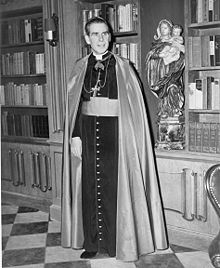



The ferraiolo (also ferraiuolo, ferraiolone) is a type of cape traditionally worn by clergy in the Catholic Church on formal, non-liturgical occasions.[1] It can be worn over the shoulders, or behind them, extends in length to the ankles, is tied in a bow by narrow strips of cloth at the front, and does not have any 'trim' or piping on it.
The ferraiolo originated as a knee-length item of clothing for Roman nobility. It became a church garment in the 15th century when colours were associated with ranks in the church hierarchy.[1]
The colour of the ferraiolo is determined by the rank of the cleric, being black for secular priests, violet for protonotaries apostolic and bishops, and scarlet for cardinals.[2]
Before 1969, members of religious orders could use a ferraiolo that matched the color of their habit. The colors also changed during sede vacante.[1]
Cardinals, and patriarchs who are not cardinals, use a ferraiolo of watered silk. Archbishops, bishops and protonotaries may use silk but not watered silk, unless specifically permitted.[1] Lesser prelates may use faille but should use wool and wear the ferraiolo behind the shoulders.[1]

Pope Paul VI encouraged wearing the ferraiolo at formal, non-liturgical occasions.[1]
The Pope may use a cape but does not wear a ferraiolo.[1]
|
| |||||||||
|---|---|---|---|---|---|---|---|---|---|
|
| |||||||||
| Headwear |
| ||||||||
| Neckwear |
| ||||||||
| Tops |
| ||||||||
| Trousers |
| ||||||||
| Suits and uniforms |
| ||||||||
| Dresses and gowns |
| ||||||||
| Skirts |
| ||||||||
| Underwear and lingerie |
| ||||||||
| Coats and outerwear |
| ||||||||
| Nightwear |
| ||||||||
| Swimwear |
| ||||||||
| Footwear |
| ||||||||
| Legwear |
| ||||||||
| Accessories |
| ||||||||
| Dress codes |
| ||||||||
| Related |
| ||||||||